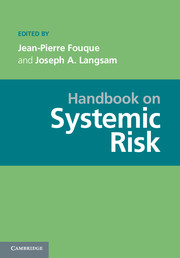Book contents
- Frontmatter
- Contents
- Contributors
- Introduction
- PART I DATA: THE PREREQUISITE FOR MANAGING SYSTEMIC RISK
- 1 Systemic Risk Information Requirements: Current Environment, Needs, and Approaches for Development
- 2 Aligning Models and Data for Systemic Risk Analysis
- 3 Applying FpML
- 4 Data Integration for Systemic Risk in the Financial System
- 5 Semantics in Systemic Risk Management
- PART II STATISTICS AND SYSTEMIC RISK
- PART III MEASURING AND REGULATING SYSTEMIC RISK
- PART IV NETWORKS
- PART V SYSTEMIC RISK ANDMATHEMATICAL FINANCE
- PART VI COUNTERPARTY RISK AND SYSTEMIC RISK
- PART VII ALGORITHMIC TRADING
- PART VIII BEHAVIORAL FINANCE: THE PSYCHOLOGICAL DIMENSION OF SYSTEMIC RISK
- PART IX REGULATION
- PART X COMPUTATIONAL ISSUES AND REQUIREMENTS
- PART XI ACCOUNTING ISSUES
- References
3 - Applying FpML
from PART I - DATA: THE PREREQUISITE FOR MANAGING SYSTEMIC RISK
Published online by Cambridge University Press: 05 June 2013
- Frontmatter
- Contents
- Contributors
- Introduction
- PART I DATA: THE PREREQUISITE FOR MANAGING SYSTEMIC RISK
- 1 Systemic Risk Information Requirements: Current Environment, Needs, and Approaches for Development
- 2 Aligning Models and Data for Systemic Risk Analysis
- 3 Applying FpML
- 4 Data Integration for Systemic Risk in the Financial System
- 5 Semantics in Systemic Risk Management
- PART II STATISTICS AND SYSTEMIC RISK
- PART III MEASURING AND REGULATING SYSTEMIC RISK
- PART IV NETWORKS
- PART V SYSTEMIC RISK ANDMATHEMATICAL FINANCE
- PART VI COUNTERPARTY RISK AND SYSTEMIC RISK
- PART VII ALGORITHMIC TRADING
- PART VIII BEHAVIORAL FINANCE: THE PSYCHOLOGICAL DIMENSION OF SYSTEMIC RISK
- PART IX REGULATION
- PART X COMPUTATIONAL ISSUES AND REQUIREMENTS
- PART XI ACCOUNTING ISSUES
- References
Summary
Abstract FpML is the industry-standard protocol for complex financial products. It is based on XML (eXtensible Markup Language), the standard meta-language for describing data shared between applications. This chapter describes FpML and shows how it can be used as a language for expressing financial contracts. If financial contracts are expressed in text, they are very difficult to reason with computationally. Yet, computer-driven analysis of complex networks of contracts, and long chains of dependencies in financial events, is likely to be important for systemic risk assessment. This chapter suggests how FpML can be helpful in this regard.
Introduction
The ‘Financial products Markup Language’ (FpML) is an open standard based on XML and XML Schema technology which has been developed by the financial industry to help streamline the processing of ‘Over the Counter’ (OTC) derivative transactions. These transactions are a significant component of today's capital markets and a major source of information technology investment for the firms involved since they carry high monetary value and risk.
Derivatives products
A derivative is a contract which takes a property of another financial instrument, for example an interest rate, a foreign exchange rate or a stock price, and uses it to define a series of actual or potential payouts that will occur over the life of the contract.
- Type
- Chapter
- Information
- Handbook on Systemic Risk , pp. 66 - 92Publisher: Cambridge University PressPrint publication year: 2013



